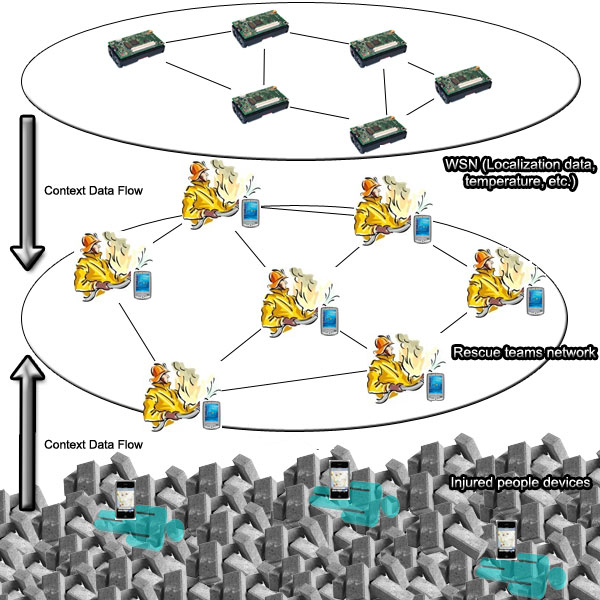ScenarioRECOWER addresses the realization of context-aware services in disaster area scenarios. Consequently, our principal scenario groups different mobile devices, belonging to the different rescue team members and/or injured people, to build a final heterogeneous MANET useful to address context data distribution and access into the disaster area. According to people movements, mobile devices, such as PDAs and/or cellular phones, randomly roam into the disaster area while collecting and distributing context data. Each device has its own local context-aware services, and uses its local RECOWER instance to connect with neighbors and to build the final MANET. From a service point-of-view, each service declares its context needs to its own local RECOWER instance that, in its turn, uses this information to route context data. Besides, each service registers local context data sources to generate and disseminate new context data. In finer details, context data can be generated by using either logical (e.g., a database) or physical (e.g., a pressure) sensors. In the first case, a mobile device can define and share a local set of context data with neighbors: to be more concrete, it can disseminate the medical records associated with its owner. In the second case, a mobile device can access real sensors to retrieve data. These sensors can be deployed either on the mobile device itself (e.g., a PDA with embedded temperature and light sensors), or in a pre-existing Wireless Sensor Networks (WSNs) available in the incident area. Despite traditional mobile systems, RECOWER does not assume an infrastructure-based approach to perform context data distribution. As main design guideline, RECOWER groups mobile nodes to compose a MANET, and exploits only ad-hoc links between them to perform context data distribution. RECOWER can also exploit available fixed infrastructure, but this modality is considered exceptional rather than usual. In fact, on the one hand, terrestrial infrastructure (such as 3G/4G networks) could be completely damaged by the disaster; on the other hand, satellite communications, even if more robust, suffer very low bandwidth communication links, and required communication equipments are costly and not widespread. To conclude, RECOWER principal scenario can be represented as follows. Mobile devices belonging to rescue team members build cooperative groups in which context data are exchanged using ad-hoc heterogeneous communications. If available, pre-existing Wireless Sensor Network (WSN) in the incident area can be used to partially address data production. Finally, pre-existing terrestrial and/or satellite infrastructure can be used to improve context data distribution and access.
|
